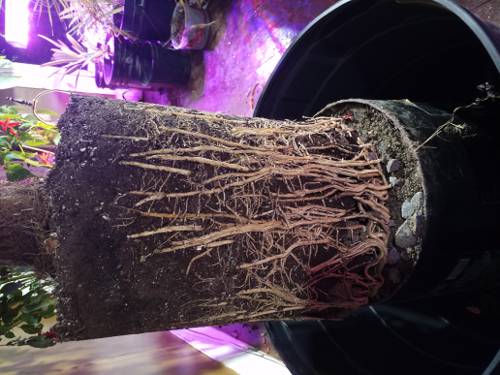
FAQ About Indoor Plant Root Rot Prevention and Management

What is root rot in indoor plants?
Root rot is a common disease in indoor plants characterized by the decay of plant roots, leading to stunted growth and often plant death. It usually occurs due to overwatering or poor drainage, resulting in favorable conditions for fungi or bacteria that decompose the roots.

How can I tell if my indoor plant has root rot?
Signs of root rot include yellowing or wilting leaves, brown and mushy roots, and a foul odor emanating from the soil. The plant might also show signs of stunted growth or sudden wilting despite adequate watering.

What causes root rot in indoor plants?
Root rot is typically caused by overwatering and poor soil drainage. These conditions create a waterlogged environment, which is conducive to the growth of fungi such as Phytophthora and Pythium, which cause the roots to decay.

How can I prevent root rot in indoor plants?
To prevent root rot, ensure proper drainage by using pots with drainage holes and avoiding overwatering by allowing the topsoil to dry out between waterings. Also, use a well-aerated soil mix that facilitates good drainage and monitor humidity levels to prevent excessive moisture.

What steps should be taken to treat root rot in indoor plants?
To treat root rot, first, remove the plant from its pot and inspect the roots, trimming away all affected roots with sterilized scissors. Then, repot the plant in fresh, well-draining potting soil, ensuring that the pot has proper drainage. Reduce watering frequency and monitor the plant closely for recovery.

Can root rot spread to other plants?
Yes, root rot can spread to other plants, especially if they are in close proximity or share the same water source. Pathogens in contaminated soil or water can infect other susceptible plants. It's important to isolate affected plants and sterilize tools and pots.

What kind of soil is best for preventing root rot?
A well-draining, aerated soil mix is best for preventing root rot. Soil containing materials such as perlite, vermiculite, or coarse sand can enhance drainage and reduce the risk of waterlogging, thus helping prevent root rot.

How often should I water indoor plants to prevent root rot?
The frequency of watering should depend on the specific plant species, humidity, temperature, and pot size. A general rule is to let the top 1-2 inches of soil dry out before watering again. Adjust your watering schedule based on seasonal changes and plant needs.

Is it possible to save a plant with severe root rot?
Saving a plant with severe root rot can be challenging but is sometimes possible if the infection is not too advanced. Trim away all affected roots and repot the plant in fresh soil, improving drainage. Subsequent care and avoiding overwatering are crucial for recovery.

What types of indoor plants are most susceptible to root rot?
Indoor plants that prefer dry, well-drained soil conditions, such as succulents and cacti, are particularly susceptible to root rot if overwatered. Tropical plants that reside in poor-draining environments can also be at risk.

Can over-fertilizing contribute to root rot in indoor plants?
Yes, over-fertilizing can contribute to root rot as it can lead to salt buildup in the soil, which may hinder root function and health. This weakening of the root system can make the plant more susceptible to root rot pathogens.

Should I use fungicides to prevent root rot?
Fungicides can help prevent root rot, especially if you suspect a fungal infection and other preventive measures fail. However, they should be used cautiously and as a last resort. Focus primarily on adjusting cultural practices like watering and ensuring good drainage.

How does poor drainage lead to root rot?
Poor drainage leads to excess water in the soil, creating an anaerobic environment where little oxygen is available. This condition is ideal for root rot-causing fungi to thrive and cause the roots to decay.

Are some pot types better at preventing root rot?
Pots with adequate drainage holes are essential for preventing root rot. Terra-cotta or clay pots, which allow for greater airflow and water evaporation, are usually better at preventing root rot compared to plastic pots.

How do I know if my potting soil has good drainage?
To test drainage, water the plant and observe how long it takes for water to emerge from the drainage holes. Good potting soil will allow water to drain quickly within a few minutes. Persistent water pooling indicates poor drainage.

How does soil aeration impact root health?
Proper aeration ensures that oxygen reaches the roots, which is crucial for their health and function. Good aeration prevents the waterlogged conditions that lead to root rot by allowing excess water to drain effectively.

What are common misconceptions about root rot?
A common misconception is that root rot only occurs in overwatered plants. While overwatering is a primary cause, poor drainage, unsuitable soil, and even certain fungal diseases can also lead to root rot.

Can repotting stress exacerbate root rot?
Repotting stress can make plants more susceptible to root rot if not done correctly. It's important to handle plants gently, choose appropriate soil, and ensure the roots are not waterlogged after repotting to prevent additional stress.

Is root rot more common in certain climates?
Root rot is more common in humid climates where soil stays moist for longer periods. Indoor environments with high humidity, poor ventilation, and incorrect watering practices can also increase the risk of root rot.

What maintenance tips can help keep roots healthy and prevent rot?
Regularly check for proper soil moisture levels and adjust watering as needed. Ensure your plants are in well-draining containers with quality soil, and remember to clean and sterilize tools and pots between uses. Monitoring the plant’s overall health and environment will also help prevent root rot.
